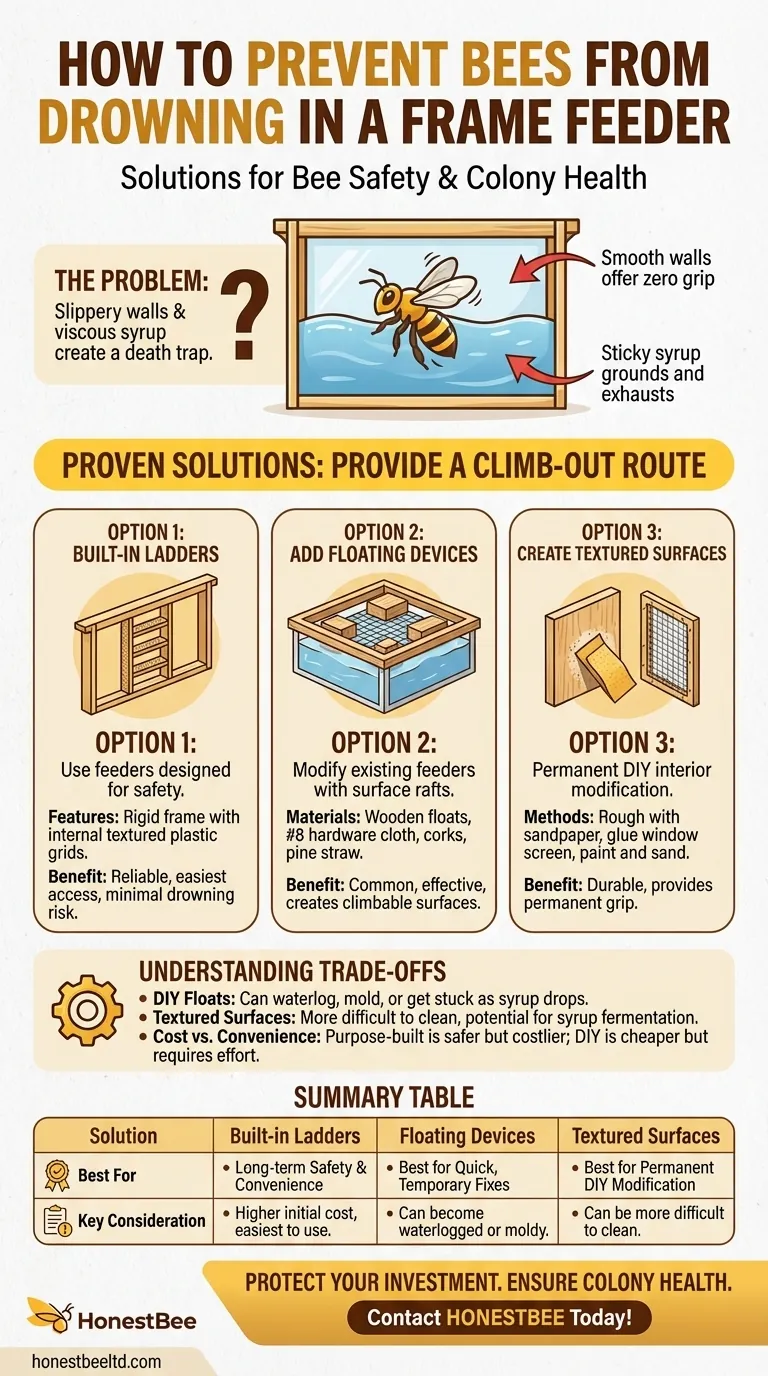To prevent bees from drowning in a frame feeder, you must provide them with a reliable way to climb out if they fall in. This is achieved by either using a feeder with built-in textured ladders or by modifying your existing feeder by adding a floating device, mesh netting, or creating a permanent rough interior surface.
The core problem with many frame feeders is their smooth, slippery plastic walls, which offer no grip for a wet bee. The solution is simple: introduce a physical structure—be it a ladder, a float, or a textured surface—that allows bees to safely access the syrup and easily climb out.

Why Bees Drown in Frame Feeders
Understanding the fundamental design flaw in many common feeders is the first step to solving the problem permanently. A frame feeder can become a death trap due to a combination of two factors.
The Slippery Wall Problem
Many inexpensive frame feeders are made from molded plastic. The interior surfaces are often perfectly smooth, which makes them easy to clean but provides zero grip for a bee's feet, especially once it's covered in sticky syrup.
The Dangers of Viscous Syrup
Syrup is sticky and heavy. Once a bee falls in, its wings become saturated, making it impossible to fly. Its struggle to climb the slick walls only exhausts it, leading it to quickly drown.
Proven Solutions to Prevent Drowning
You can either purchase feeders designed for safety or modify existing ones. Both approaches are effective when implemented correctly.
Option 1: Use Feeders with Built-in Ladders
The most reliable solution is to use frame feeders that are designed with bee safety in mind. These models often feature a rigid frame with integrated "caps and ladders."
These internal structures are typically rough-textured plastic grids that extend down into the syrup reservoir. Bees can crawl down them to access the feed and easily climb back out, virtually eliminating the risk of drowning.
Option 2: Add Floating Devices
If you have smooth-walled feeders, adding something that floats on the syrup's surface can serve as a life raft. This is a common and effective modification.
Simple wooden floats, sometimes sold with the feeder, work well. You can also use pieces of #8 hardware cloth cut to size, wine corks, or even a layer of pine straw. The goal is to create a climbable surface across the entire liquid area.
Option 3: Create Permanent Textured Surfaces
For a more permanent DIY solution, you can modify the feeder's interior walls to provide a permanent grip.
One method is to rough up the interior plastic with coarse sandpaper. Another is to glue plastic window screen or netting to the inside walls, creating a permanent ladder. A less common but effective method involves painting the interior with non-toxic paint and sprinkling coarse sand on it before it dries.
Understanding the Trade-offs and Pitfalls
While the solutions are straightforward, each comes with considerations. Being aware of them will help you manage your feeders more effectively.
The Challenge of DIY Floats
Floats made of wood or other organic materials can absorb syrup, become waterlogged, and sometimes develop mold. They can also get stuck to the sides as the syrup level drops, creating gaps where bees can get trapped.
The Difficulty of Cleaning
Creating a permanent textured surface with paint and sand makes the feeder much harder to clean thoroughly. Any leftover syrup can ferment or grow mold, which is unhealthy for the colony.
The Cost vs. Convenience Factor
Purpose-built feeders with integrated ladders are the safest and most convenient option, but they are also more expensive. Modifying cheaper, smooth-walled feeders is cost-effective but requires more initial setup and ongoing maintenance.
Making the Right Choice for Your Goal
Your best strategy depends on whether you are purchasing new equipment or working with what you already have.
- If your primary focus is long-term safety and convenience: Invest in well-designed frame feeders with built-in caps and ladder systems.
- If your primary focus is modifying existing feeders: Adding custom-cut sections of plastic mesh or #8 hardware cloth provides a durable and cleanable solution.
- If you need an immediate, temporary fix: Tossing in a handful of wine corks or a wooden float will work as a stopgap measure to save bees now.
A safe feeder is a small adjustment that protects your colony's population and supports its overall health.
Summary Table:
| Solution | Best For | Key Consideration |
|---|---|---|
| Feeders with Built-in Ladders | Long-term safety & convenience | Higher initial cost, easiest to use |
| Adding Floating Devices | Quick, temporary fixes | Can become waterlogged or moldy |
| Creating Textured Surfaces | Permanent DIY modification | Can be more difficult to clean |
Protect your investment and ensure your colony's health with the right equipment. HONESTBEE supplies durable, bee-safe beekeeping supplies and equipment—including frame feeders designed to prevent drowning—to commercial apiaries and beekeeping equipment distributors through our wholesale-focused operations. Let's discuss your needs and how our products can support your operation's success. Contact HONESTBEE today!
Visual Guide

Related Products
- Professional In-Hive Frame Bee Feeder by HONESTBEE
- 3.5L Plastic Beehive Frame Feeder Deep Frame Water Feeder for In Hive Use
- Professional Hive Front Entrance Bee Feeder
- Professional In-Hive Bee Feeder HONESTBEE Frame for Beekeeping
- Boardman Entrance Bee Feeder Durable Galvanized Steel and Wood Construction for Beekeeping
People Also Ask
- Are frame feeders good? Maximize Your Hive's Health with the Right Feeding Strategy
- What are the types of internal feeders used in beekeeping? Optimize Your Hive's Nutrition Strategy
- What is a frame feeder? A High-Capacity, Secure In-Hive Feeding Solution
- What are the advantages of using a frame feeder? Boost Hive Health with In-Hive Feeding
- What are the different types of honey bee feeders? Choose the Right Feeder for Your Hive



















